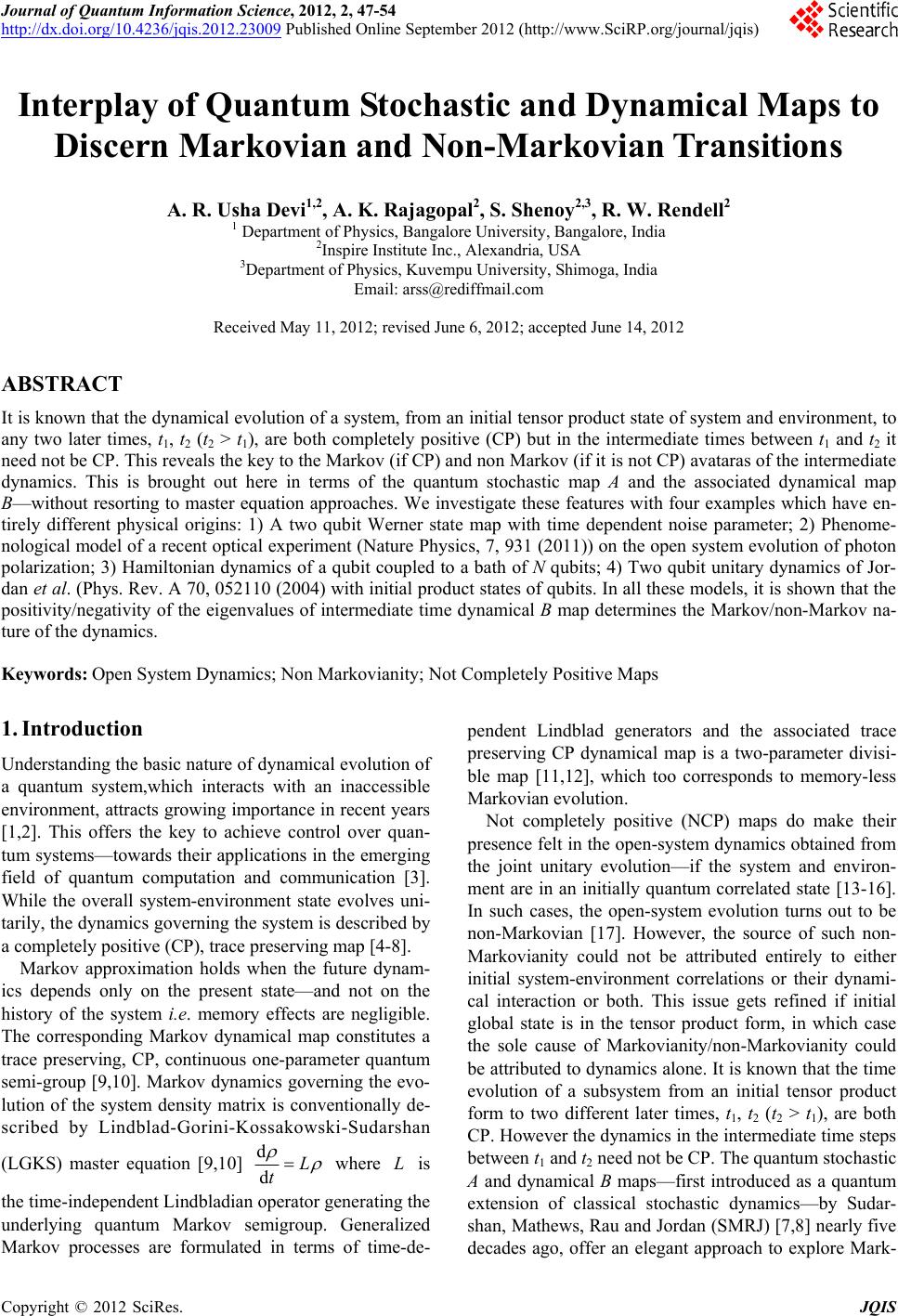 Journal of Quantum Information Science, 2012, 2, 47-54 http://dx.doi.org/10.4236/jqis.2012.23009 Published Online September 2012 (http://www.SciRP.org/journal/jqis) Interplay of Quantum Stochastic and Dynamical Maps to Discern Markovian and Non-Markovian Transitions A. R. Usha Devi1,2, A. K. Rajagopal2, S. Shenoy2,3, R. W. Rendell2 1 Department of Physics, Bangalore University, Bangalore, India 2Inspire Institute Inc., Alexandria, USA 3Department of Physics, Kuvempu University, Shimoga, India Email: arss@rediffmail.com Received May 11, 2012; revised June 6, 2012; accepted June 14, 2012 ABSTRACT It is known that the dynamical evolution of a system, from an initial tensor product state of system and environment, to any two later times, t1, t2 (t2 > t1), are both completely positive (CP) but in the intermediate times between t1 and t2 it need not be CP. This reveals the key to the Markov (if CP) and non Markov (if it is not CP) avataras of the intermediate dynamics. This is brought out here in terms of the quantum stochastic map A and the associated dynamical map B—without resorting to master equation approaches. We investigate these features with four examples which have en- tirely different physical origins: 1) A two qubit Werner state map with time dependent noise parameter; 2) Phenome- nological model of a recent optical experiment (Nature Physics, 7, 931 (2011)) on the open system evolution of photon polarization; 3) Hamiltonian dynamics of a qubit coupled to a bath of N qubits; 4) Two qubit unitary dynamics of Jor- dan et al. (Phys. Rev. A 70, 052110 (2004) with initial product states of qubits. In all these models, it is shown that the positivity/negativity of the eigenvalues of intermediate time dynamical B map determines the Markov/non-Markov na- ture of the dynamics. Keywords: Open System Dynamics; Non Markovianity; Not Completely Positive Maps 1. Introduction Understanding the basic nature of dynamical evolution of a quantum system,which interacts with an inaccessible environment, attracts growing importance in recent years [1,2]. This offers the key to achieve control over quan- tum systems—towards their applications in the emerging field of quantum computation and communication [3]. While the overall system-environment state evolves uni- tarily, the dynamics governing the system is described by a completely positive (CP), trace preserving map [4-8]. Markov approximation holds when the future dynam- ics depends only on the present state—and not on the history of the system i.e. memory effects are negligible. The corresponding Markov dynamical map constitutes a trace preserving, CP, continuous one-parameter quantum semi-group [9,10]. Markov dynamics governing the evo- lution of the system density matrix is conventionally de- scribed by Lindblad-Gorini-Kossakowski-Sudarshan (LGKS) master equation [9,10] d dL t where is L the time-independent Lindbladian operator generating the underlying quantum Markov semigroup. Generalized Markov processes are formulated in terms of time-de- pendent Lindblad generators and the associated trace preserving CP dynamical map is a two-parameter divisi- ble map [11,12], which too corresponds to memory-less Markovian evolution. Not completely positive (NCP) maps do make their presence felt in the open-system dynamics obtained from the joint unitary evolution—if the system and environ- ment are in an initially quantum correlated state [13-16]. In such cases, the open-system evolution turns out to be non-Markovian [17]. However, the source of such non- Markovianity could not be attributed entirely to either initial system-environment correlations or their dynami- cal interaction or both. This issue gets refined if initial global state is in the tensor product form, in which case the sole cause of Markovianity/non-Markovianity could be attributed to dynamics alone. It is known that the time evolution of a subsystem from an initial tensor product form to two different later times, t1, t2 (t2 > t1), are both CP. However the dynamics in the intermediate time steps between t1 and t2 need not be CP. The quantum stochastic A and dynamical B maps—first introduced as a quantum extension of classical stochastic dynamics—by Sudar- shan, Mathews, Rau and Jordan (SMRJ) [7,8] nearly five decades ago, offer an elegant approach to explore Mark- C opyright © 2012 SciRes. JQIS 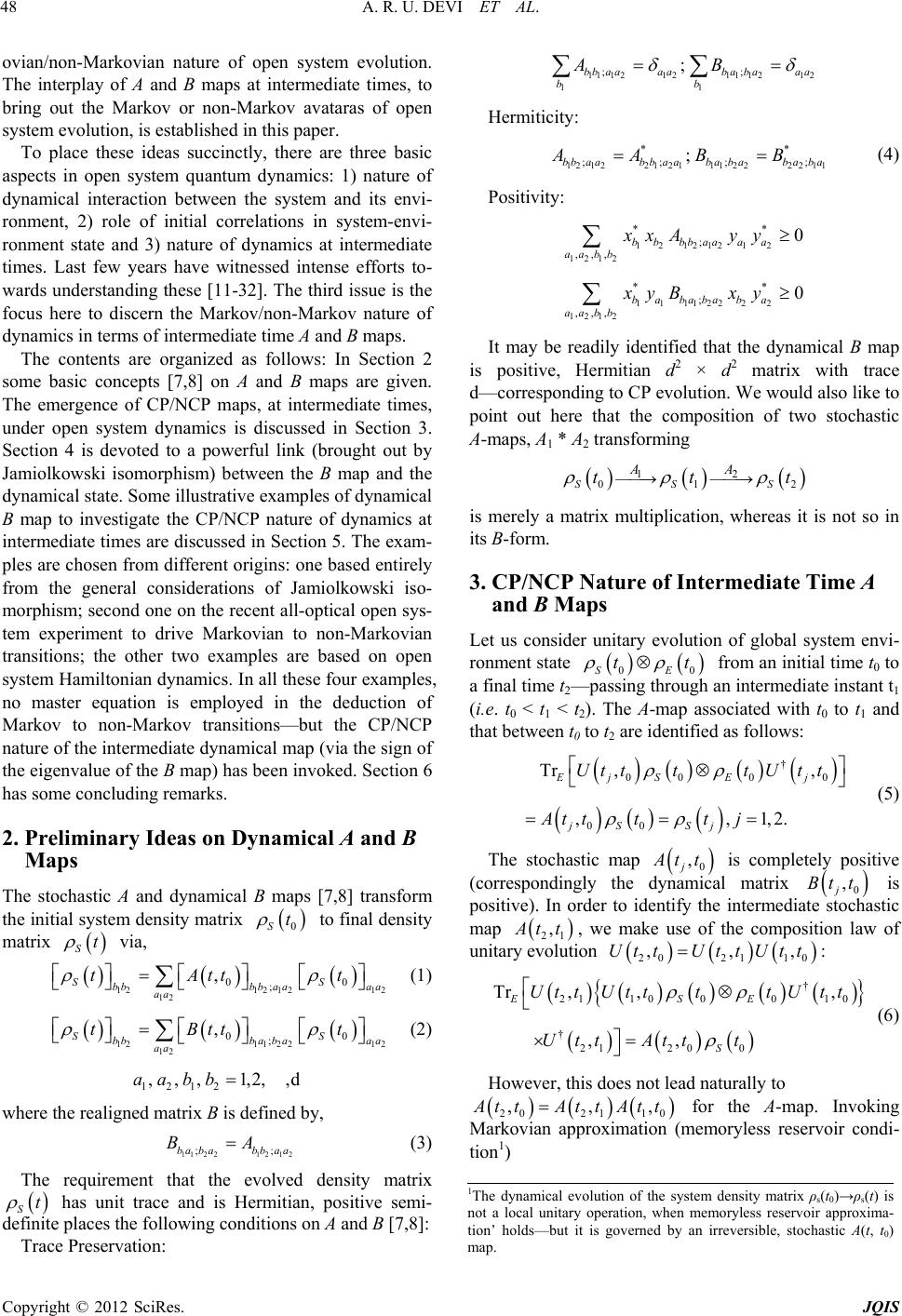 A. R. U. DEVI ET AL. 48 ovian/non-Markovian nature of open system evolution. The interplay of A and B maps at intermediate times, to bring out the Markov or non-Markov avataras of open system evolution, is established in this paper. To place these ideas succinctly, there are three basic aspects in open system quantum dynamics: 1) nature of dynamical interaction between the system and its envi- ronment, 2) role of initial correlations in system-envi- ronment state and 3) nature of dynamics at intermediate times. Last few years have witnessed intense efforts to- wards understanding these [11-32]. The third issue is the focus here to discern the Markov/non-Markov nature of dynamics in terms of intermediate time A and B maps. The contents are organized as follows: In Section 2 some basic concepts [7,8] on A and B maps are given. The emergence of CP/NCP maps, at intermediate times, under open system dynamics is discussed in Section 3. Section 4 is devoted to a powerful link (brought out by Jamiolkowski isomorphism) between the B map and the dynamical state. Some illustrative examples of dynamical B map to investigate the CP/NCP nature of dynamics at intermediate times are discussed in Section 5. The exam- ples are chosen from different origins: one based entirely from the general considerations of Jamiolkowski iso- morphism; second one on the recent all-optical open sys- tem experiment to drive Markovian to non-Markovian transitions; the other two examples are based on open system Hamiltonian dynamics. In all these four examples, no master equation is employed in the deduction of Markov to non-Markov transitions—but the CP/NCP nature of the intermediate dynamical map (via the sign of the eigenvalue of the B map) has been invoked. Section 6 has some concluding remarks. 2. Preliminary Ideas on Dynamical A and B Maps The stochastic A and dynamical B maps [7,8] transform the initial system density matrix to final density matrix via, 0St St 12 12 1212 12 00 ; , SS bb bb aaaa aa tAtt t (1) 12 112 212 12 00 ; , SS bb bab aaa aa tBtt t (2) 1212 ,,,1,2,,daabb where the realigned matrix B is defined by, 112 2121 2 ;bab abbaa BA ; (3) The requirement that the evolved density matrix has unit trace and is Hermitian, positive semi- definite places the following conditions on A and B [7,8]: St Trace Preservation: 111212111212 11 ;; ; bbaa aababa aa bb AB Hermiticity: 1212212111 222211 ** ;;; ; bbaa bbaababa baba AABB ; (4) Positivity: 12 1212 12 1212 ** ; ,,, 0 bbbbaaa a aa bb xx Ayy 1111222 2 1212 ** ; ,,, 0 ba bababa aa bb xyBxy It may be readily identified that the dynamical B map is positive, Hermitian d2 × d2 matrix with trace d—corresponding to CP evolution. We would also like to point out here that the composition of two stochastic A-maps, A1 * A2 transforming 12 01SS AA tt 2S t is merely a matrix multiplication, whereas it is not so in its B-form. 3. CP/NCP Nature of Intermediate Time A and B Maps Let us consider unitary evolution of global system envi- ronment state 0 t 0SE from an initial time t0 to a final time t2—passing through an intermediate instant t1 (i.e. t0 < t1 < t2). The A-map associated with t0 to t1 and that between t0 to t2 are identified as follows: t † 00 00 00 Tr,, ,,1,2 EjS Ej jS Sj Ut tttUt t At tttj . (5) The stochastic map 0 , j tt is completely positive (correspondingly the dynamical matrix 0 , j Bt t is positive). In order to identify the intermediate stochastic map 21 , tt , we make use of the composition law of unitary evolution 20 t Ut 211 ,,Utt Ut 0 ,t: † 21 100010 † 2120 0 Tr ,,, ,, ESE S Ut tUttttUtt UttAttt (6) However, this does not lead naturally to 202110 ,,, ttAtt Att for the A-map. Invoking Markovian approximation (memoryless reservoir condi- tion1) 1The dynamical evolution of the system density matrix ρs(t0)→ρs(t) is not a local unitary operation, when memoryless reservoir approxima- tion’ holds—but it is governed by an irreversible, stochastic A(t, t 0) map . Copyright © 2012 SciRes. JQIS 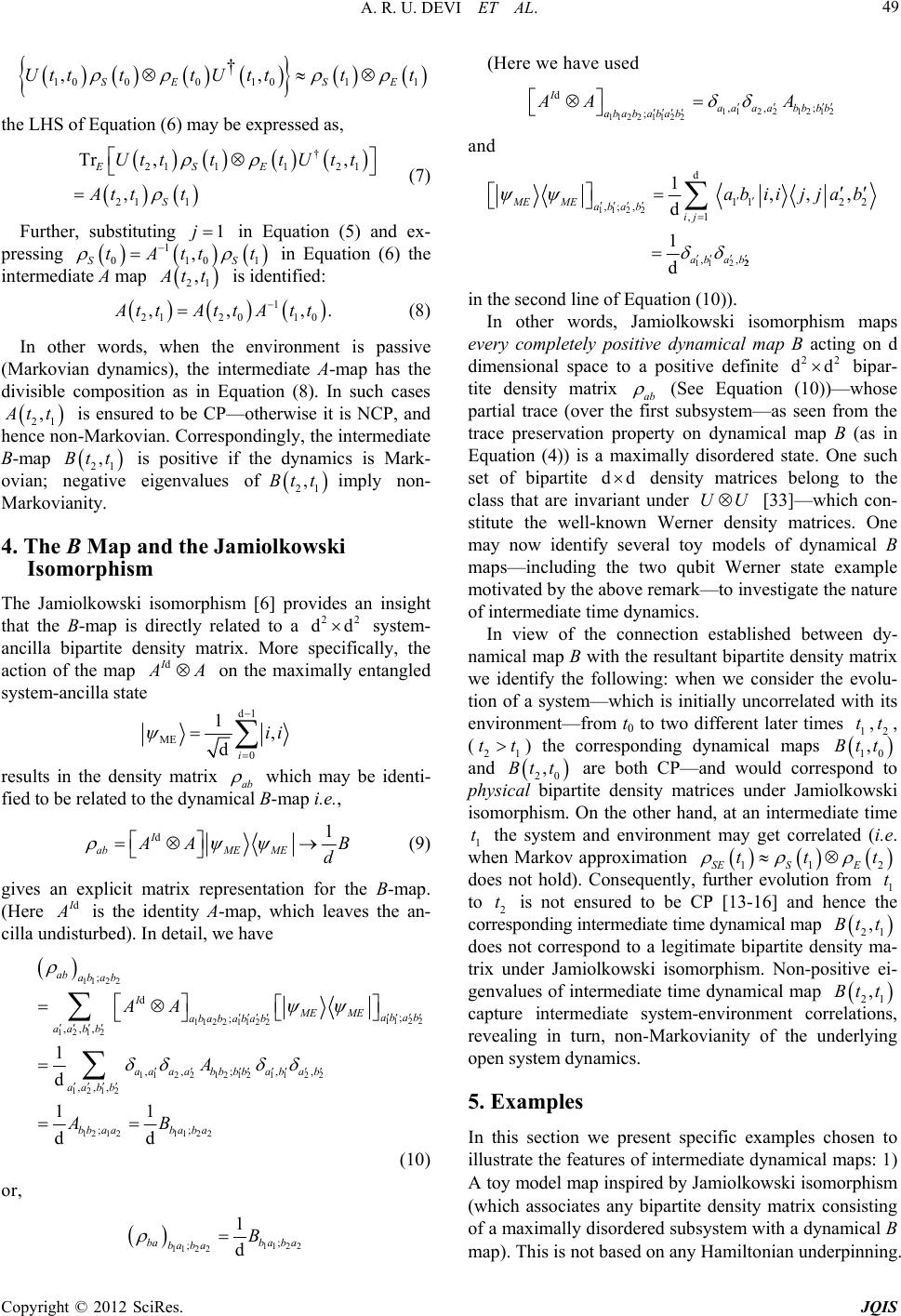 A. R. U. DEVI ET AL. 49 01110010 † ,, SE SE Utttt Utttt the LHS of Equation (6) may be expressed as, † 21 1121 21 1 Tr,, , ESE S Ut tttUt t At tt (7) Further, substituting in Equation (5) and ex- pressing 1SS in Equation (6) the intermediate A map 1j 01 ,tt 21 , 1 0 tA t tt is identified: 1 2120 10 ,,,. ttAtt Att (8) In other words, when the environment is passive (Markovian dynamics), the intermediate A-map has the divisible composition as in Equation (8). In such cases 21 , tt is ensured to be CP—otherwise it is NCP, and hence non-Markovian. Correspondingly, the intermediate B-map is positive if the dynamics is Mark- ovian; negative eigenvalues ofimply non- Markovianity. 21 ,Bt t 2 21 ,Bt t 4. The B Map and the Jamiolkowski Isomorphism The Jamiolkowski isomorphism [6] provides an insight that the B-map is directly related to a system- ancilla bipartite density matrix. More specifically, the action of the map 2 dd dI A on the maximally entangled system-ancilla state d1 ME 0 1, di ii results in the density matrix ab which may be identi- fied to be related to the dynamical B-map i.e., d1 I abME ME A d B (9) gives an explicit matrix representation for the B-map. (Here d is the identity A-map, which leaves the an- cilla undisturbed). In detail, we have 112 2 112 2 1122 1122 1212 112 212121122 1212 12121122 ; d ; ; ,,, ,,; ,, ,,, ;; 1 d 11 dd ab abab I MEME abab abababab aa bb a aaabbbba bab aa bb bbaabab a AA A AB (10) or, 112 2 112 2; ; 1 d bab aba bab aB (Here we have used 1 1221212 1122 1122 d ,, ; ; I aaa abbbb abab abab AA A and 11 2 2 112 22 d 112 2 ,; , ,1 ,, 1,, , d 1 d MEME abab ij abab abiijjab in the second line of Equation (10)). In other words, Jamiolkowski isomorphism maps every completely positive dynamical map B acting on d dimensional space to a positive definite 2 dd 2 bipar- tite density matrix ab (See Equation (10))—whose partial trace (over the first subsystem—as seen from the trace preservation property on dynamical map B (as in Equation (4)) is a maximally disordered state. One such set of bipartite dd density matrices belong to the class that are invariant under [33]—which con- stitute the well-known Werner density matrices. One may now identify several toy models of dynamical B maps—including the two qubit Werner state example motivated by the above remark—to investigate the nature of intermediate time dynamics. UU In view of the connection established between dy- namical map B with the resultant bipartite density matrix we identify the following: when we consider the evolu- tion of a system—which is initially uncorrelated with its environment—from t0 to two different later times ,, (2) the corresponding dynamical maps 1 t2 t 1 tt 10 t,Bt and 20 ,tBt t are both CP—and would correspond to physical bipartite density matrices under Jamiolkowski isomorphism. On the other hand, at an intermediate time 1 the system and environment may get correlated (i.e. when Markov approximation t 11SESE does not hold). Consequently, further evolution from 1 to 2 is not ensured to be CP [13-16] and hence the corresponding intermediate time dynamical map 2 ttt t 21 t,Bt does not correspond to a legitimate bipartite density ma- trix under Jamiolkowski isomorphism. Non-positive ei- genvalues of intermediate time dynamical map 21 t,Bt capture intermediate system-environment correlations, revealing in turn, non-Markovianity of the underlying open system dynamics. 5. Examples In this section we present specific examples chosen to illustrate the features of intermediate dynamical maps: 1) A toy model map inspired by Jamiolkowski isomorphism (which associates any bipartite density matrix consisting of a maximally disordered subsystem with a dynamical B map). This is not based on any Hamiltonian underpinning. Copyright © 2012 SciRes. JQIS 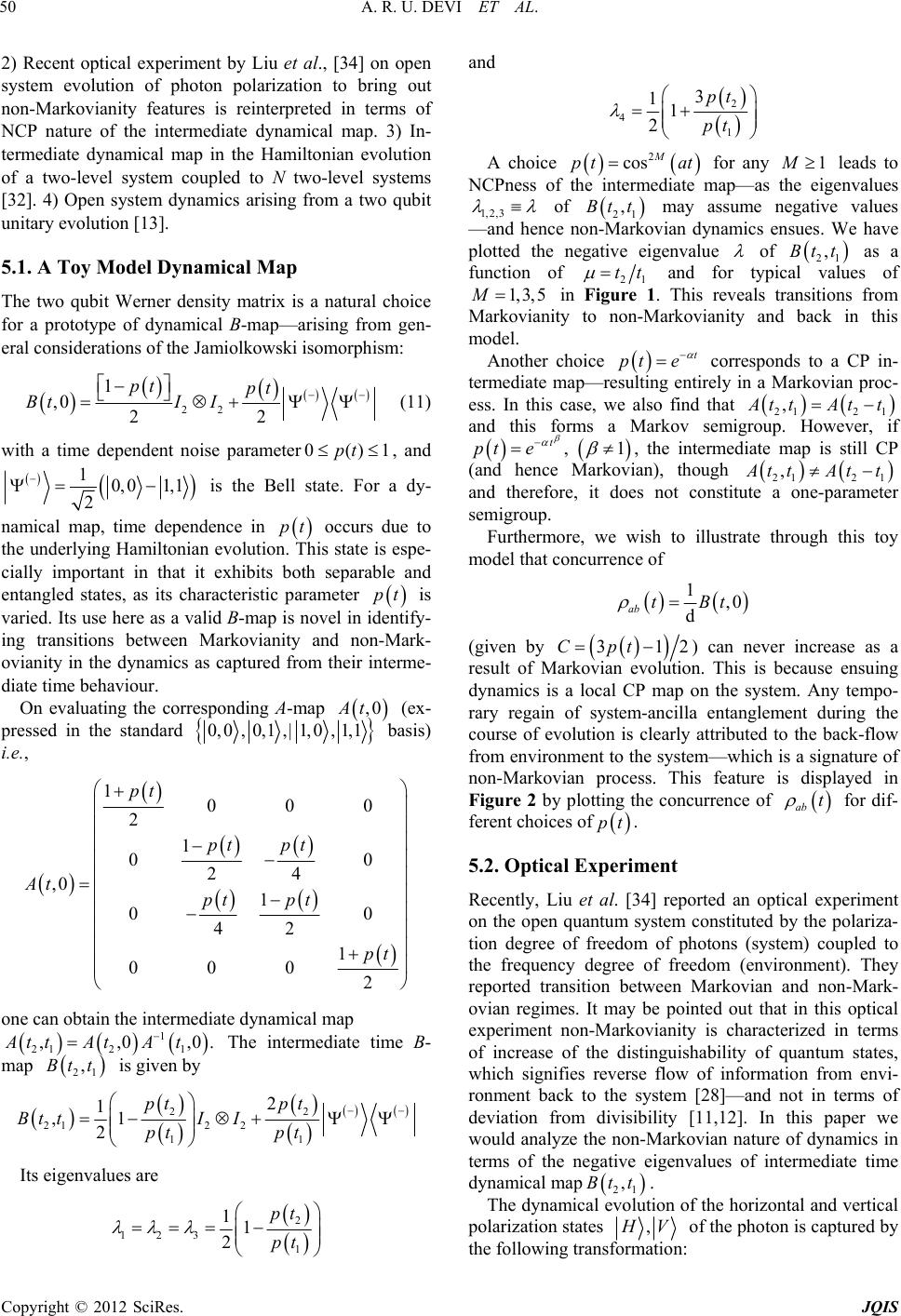 A. R. U. DEVI ET AL. 50 2) Recent optical experiment by Liu et al., [34] on open system evolution of photon polarization to bring out non-Markovianity features is reinterpreted in terms of NCP nature of the intermediate dynamical map. 3) In- termediate dynamical map in the Hamiltonian evolution of a two-level system coupled to N two-level systems [32]. 4) Open system dynamics arising from a two qubit unitary evolution [13]. 5.1. A Toy Model Dynamical Map The two qubit Werner density matrix is a natural choice for a prototype of dynamical B-map—arising from gen- eral considerations of the Jamiolkowski isomorphism: 22 1 ,0 22 pt pt BtI I 1 (11) with a time dependent noise parameter, and 0()pt 10, 01,1 2 is the Bell state. For a dy- namical map, time dependence in occurs due to the underlying Hamiltonian evolution. This state is espe- cially important in that it exhibits both separable and entangled states, as its characteristic parameter pt pt is varied. Its use here as a valid B-map is novel in identify- ing transitions between Markovianity and non-Mark- ovianity in the dynamics as captured from their interme- diate time behaviour. On evaluating the corresponding A-map ,0 t (ex- pressed in the standard basis) i.e., 0, 0,0,1,|1,0,1,1 1000 2 1 0 24 ,0 1 0 42 1 0002 pt pt pt At pt pt pt 0 0 ,0. one can obtain the intermediate dynamical map The intermediate time B- map is given by 1 21 21 ,,0At tAtAt 21 ,Bt t 22 212 2 11 2 1 ,1 2 pt pt Bt tII pt pt Its eigenvalues are 2 123 1 11 2 pt pt and 2 4 1 3 11 2 pt pt A choice 2 cos M pt at for any 1 leads to NCPness of the intermediate map—as the eigenvalues 1, 2, 3 of 21 ,Bt t may assume negative values —and hence non-Markovian dynamics ensues. We have plotted the negative eigenvalue of 21 as a function of ,Bt t 21 tt and for typical values of 1, 3, 5M in Figure 1. This reveals transitions from Markovianity to non-Markovianity and back in this model. Another choice t pte corresponds to a CP in- termediate map—resulting entirely in a Markovian proc- ess. In this case, we also find that 212 1 , ttAt t and this forms a Markov semigroup. However, if , t pte 1 , the intermediate map is still CP (and hence Markovian), though 2121 , ttAtt and therefore, it does not constitute a one-parameter semigroup. Furthermore, we wish to illustrate through this toy model that concurrence of 1,0 d ab tBt (given by 31Cpt2) can never increase as a result of Markovian evolution. This is because ensuing dynamics is a local CP map on the system. Any tempo- rary regain of system-ancilla entanglement during the course of evolution is clearly attributed to the back-flow from environment to the system—which is a signature of non-Markovian process. This feature is displayed in Figure 2 by plotting the concurrence of ab t for dif- ferent choices of pt. 5.2. Optical Experiment Recently, Liu et al. [34] reported an optical experiment on the open quantum system constituted by the polariza- tion degree of freedom of photons (system) coupled to the frequency degree of freedom (environment). They reported transition between Markovian and non-Mark- ovian regimes. It may be pointed out that in this optical experiment non-Markovianity is characterized in terms of increase of the distinguishability of quantum states, which signifies reverse flow of information from envi- ronment back to the system [28]—and not in terms of deviation from divisibility [11,12]. In this paper we would analyze the non-Markovian nature of dynamics in terms of the negative eigenvalues of intermediate time dynamical map 21 ,Bt t. The dynamical evolution of the horizontal and vertical polarization states , V of the photon is captured by the following transformation: Copyright © 2012 SciRes. JQIS  A. R. U. DEVI ET AL. 51 Figure 1. A plot of the eigenvalue of versus (,) 21 Bt t μ=tt 21 for different values of M. The dynamics is non- Markovian when assumes negative values and other- wise it is Markovian. Figure 2. Concurrence 31C=p t2 of the system- ancilla state 22 1 4 abME ME pt ρt=I I+ptψψ, vs. scaled time at, for the following choices i) Markov proc- ess: at pt =e cos2M (solid line) and ii) non-Markov process: 1 t=at,M= (dashed line) and (dot- dashed line). Note that there is a death and re-birth of en- tanglement (dash, dot-dashed lines) due to back-flow from environment. M=5 HHH VV VV * VtH V VH tVH Here denotes the decoherence function, mag- nitude of which is modelled as, t 2 2 2 2 1 22 1 2 2 11 12 1 · 141s cos in 2 nt nt nt e tAA A nt eAA (14) where VH nn n 2 is the difference between the re- fractive indices of vertically and horizontally polarized light; 1 distance between two frequency peaks (for details see [34]), 11 1,0 1. 1 AA A The corresponding A and B maps (in the ,,, HHVVHVV basis) are readily identified to be, * 10 00 00 ,0 000 00 01 t At t 0 * 100 000 0 ,0 000 0 00 1 t Bt t We construct the intermediate time dynamical map 21 ,Bt tfrom the corresponding 1 21 21 ,,0AtAt Att,0 to obtain, * 2 * 1 21 2 1 100 000 0 ,. 000 0 00 1 t t Bt t t t (16) Eigenvalues of 21 ,Bt t are given by, 2 1,4 2,3 1 1, t t 0. (17) The eigenvalue 4 can assume negative values indi- cating Markovian/non-Markovian regimes. A plot of the negative eigenvalue as a function of 1 , for different ratios 21 tt (for the choice of parameters Hz, Hz, which are em- ployed in Ref. [34]) is given in Figure 3 where one can clearly see the Markovian ( 13 1.6 10 12 1.8 10 40 ) and non-Markovian (40 ) regimes. 5.3. Hamiltonian Evolution of a Two Level System Coupled to a Bath of N Spins We now present a Hamiltonian model, which give rise to explicit structure of time dependence in the open system evolution. Interaction Hamiltonian considered here is [28,32] 1 . N kz k A HN (18) Copyright © 2012 SciRes. JQIS 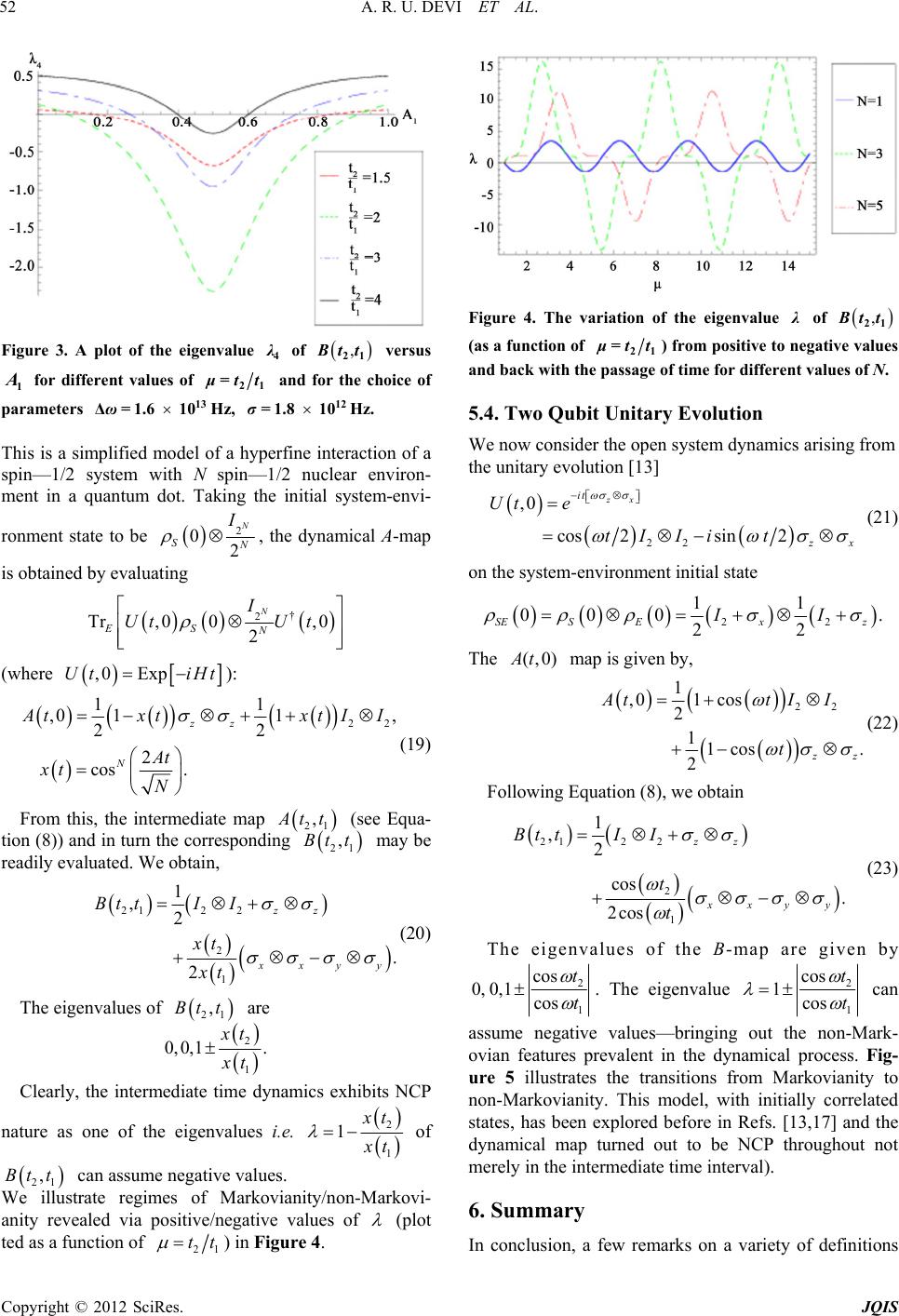 A. R. U. DEVI ET AL. 52 Figure 3. A plot of the eigenvalue of λ4 , 21 Bt t versus for different values of A1μ=t t 1 =1. 2 and for the choice of parameters Hz, Hz. 13 Δ=1.610ω 12 108σ This is a simplified model of a hyperfine interaction of a spin—1/2 system with N spin—1/2 nuclear environ- ment in a quantum dot. Taking the initial system-envi- ronment state to be 2 02 N S , the dynamical A-map is obtained by evaluating † 2 Tr,0 0,0 2 N ES N I UtU t (where ,0 ExpUt iHt): 22 11 ,0 11, 22 2 cos. zz N txt xtI At xt N I (19) From this, the intermediate map 21 , tt ,Bt (see Equa- tion (8)) and in turn the corresponding may be readily evaluated. We obtain, 21 t 2122 2 1 1 ,2 . 2 zz xxyy Bt tII xt xt (20) The eigenvalues of are 21 ,Bt t 2 1 0, 0,1. t t Clearly, the intermediate time dynamics exhibits NCP nature as one of the eigenvalues i.e. 2 1 1 t t of 21 ,Bt t can assume negative values. We illustrate regimes of Markovianity/non-Markovi- anity revealed via positive/negative values of (plot ted as a function of 21 tt ) in Figure 4. Figure 4. The variation of the eigenvalue of , 21 Bt t (as a function of μ=t t 21 ) from positive to negative values and back with the passage of time for different values of N. 5.4. Two Qubit Unitary Evolution We now consider the open system dynamics arising from the unitary evolution [13] 22 ,0 cos 2 sin2 zx it x Ut e tIIi t (21) on the system-environment initial state 22 11 000 22 SE SExz II . The (,0) t map is given by, 22 1 ,01cos 2 11cos. 2 z Att II t (22) Following Equation (8), we obtain 2122 2 1 1 ,2 cos . 2cos zz xxy y Bt tII t t (23) The eigenvalues of the B-map are given by 2 1 cos 0, 0,1cos t t . The eigenvalue 2 1 cos 1cos t t can assume negative values—bringing out the non-Mark- ovian features prevalent in the dynamical process. Fig- ure 5 illustrates the transitions from Markovianity to non-Markovianity. This model, with initially correlated states, has been explored before in Refs. [13,17] and the dynamical map turned out to be NCP throughout not merely in the intermediate time interval). 6. Summary In conclusion, a few remarks on a variety of definitions Copyright © 2012 SciRes. JQIS 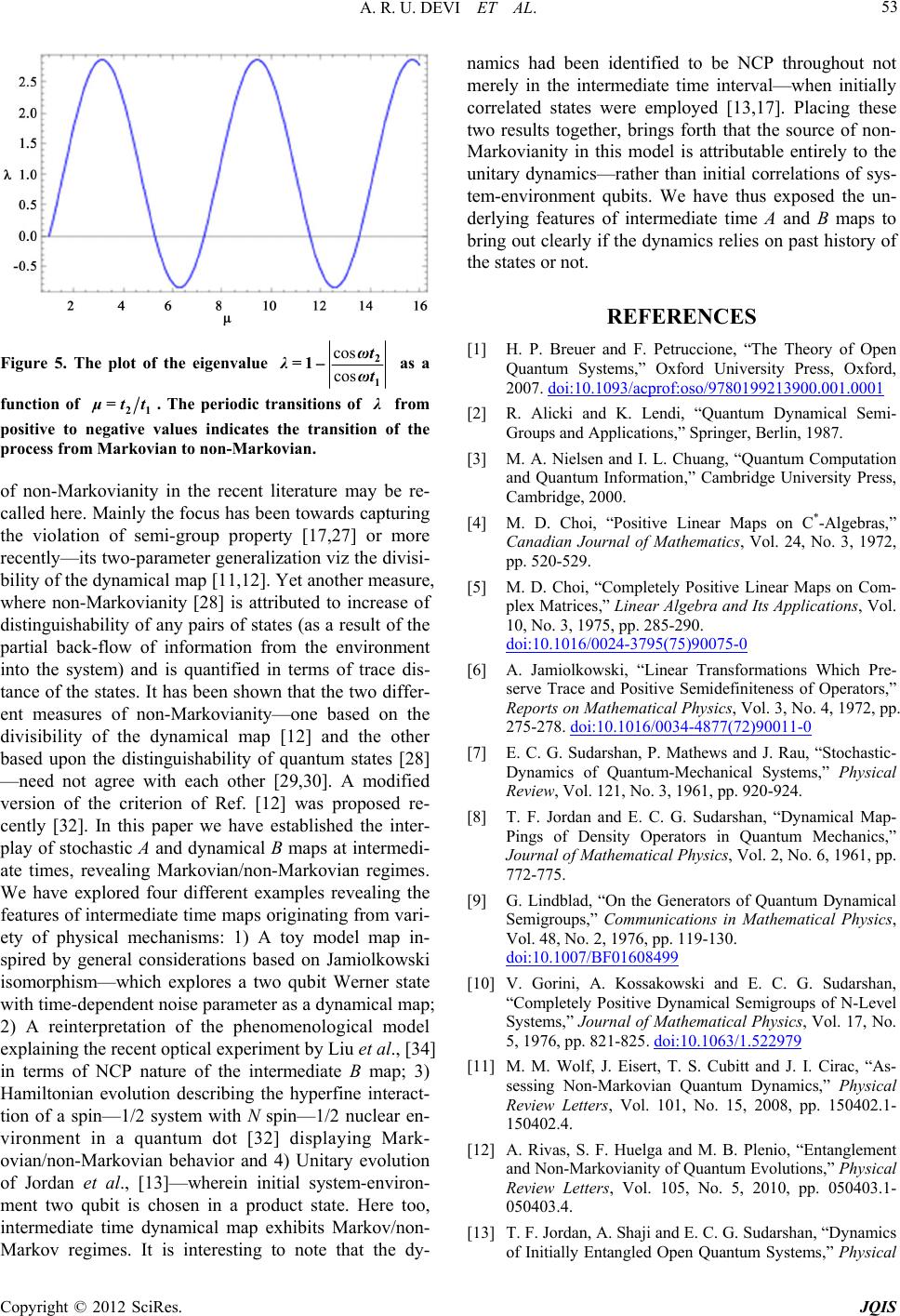 A. R. U. DEVI ET AL. 53 Figure 5. The plot of the eigenvalue cos cos 2 1 1ωt λ=ωt as a function of μ=tt 21 . The periodic transitions of from positive to negative values indicates the transition of the process from Markovian to non-Markovian. of non-Markovianity in the recent literature may be re- called here. Mainly the focus has been towards capturing the violation of semi-group property [17,27] or more recently—its two-parameter generalization viz the divisi- bility of the dynamical map [11,12]. Yet another measure, where non-Markovianity [28] is attributed to increase of distinguishability of any pairs of states (as a result of the partial back-flow of information from the environment into the system) and is quantified in terms of trace dis- tance of the states. It has been shown that the two differ- ent measures of non-Markovianity—one based on the divisibility of the dynamical map [12] and the other based upon the distinguishability of quantum states [28] —need not agree with each other [29,30]. A modified version of the criterion of Ref. [12] was proposed re- cently [32]. In this paper we have established the inter- play of stochastic A and dynamical B maps at intermedi- ate times, revealing Markovian/non-Markovian regimes. We have explored four different examples revealing the features of intermediate time maps originating from vari- ety of physical mechanisms: 1) A toy model map in- spired by general considerations based on Jamiolkowski isomorphism—which explores a two qubit Werner state with time-dependent noise parameter as a dynamical map; 2) A reinterpretation of the phenomenological model explaining the recent optical experiment by Liu et al., [34] in terms of NCP nature of the intermediate B map; 3) Hamiltonian evolution describing the hyperfine interact- tion of a spin—1/2 system with N spin—1/2 nuclear en- vironment in a quantum dot [32] displaying Mark- ovian/non-Markovian behavior and 4) Unitary evolution of Jordan et al., [13]—wherein initial system-environ- ment two qubit is chosen in a product state. Here too, intermediate time dynamical map exhibits Markov/non- Markov regimes. It is interesting to note that the dy- namics had been identified to be NCP throughout not merely in the intermediate time interval—when initially correlated states were employed [13,17]. Placing these two results together, brings forth that the source of non- Markovianity in this model is attributable entirely to the unitary dynamics—rather than initial correlations of sys- tem-environment qubits. We have thus exposed the un- derlying features of intermediate time A and B maps to bring out clearly if the dynamics relies on past history of the states or not. REFERENCES [1] H. P. Breuer and F. Petruccione, “The Theory of Open Quantum Systems,” Oxford University Press, Oxford, 2007. doi:10.1093/acprof:oso/9780199213900.001.0001 [2] R. Alicki and K. Lendi, “Quantum Dynamical Semi- Groups and Applications,” Springer, Berlin, 1987. [3] M. A. Nielsen and I. L. Chuang, “Quantum Computation and Quantum Information,” Cambridge University Press, Cambridge, 2000. [4] M. D. Choi, “Positive Linear Maps on C*-Algebras,” Canadian Journal of Mathematics, Vol. 24, No. 3, 1972, pp. 520-529. [5] M. D. Choi, “Completely Positive Linear Maps on Com- plex Matrices,” Linear Algebra and Its Applications, Vol. 10, No. 3, 1975, pp. 285-290. doi:10.1016/0024-3795(75)90075-0 [6] A. Jamiolkowski, “Linear Transformations Which Pre- serve Trace and Positive Semidefiniteness of Operators,” Reports on Mathematical Physics, Vol. 3, No. 4, 1972, pp. 275-278. doi:10.1016/0034-4877(72)90011-0 [7] E. C. G. Sudarshan, P. Mathews and J. Rau, “Stochastic- Dynamics of Quantum-Mechanical Systems,” Physical Review, Vol. 121, No. 3, 1961, pp. 920-924. [8] T. F. Jordan and E. C. G. Sudarshan, “Dynamical Map- Pings of Density Operators in Quantum Mechanics,” Journal of Mathematical Physics, Vol. 2, No. 6, 1961, pp. 772-775. [9] G. Lindblad, “On the Generators of Quantum Dynamical Semigroups,” Communications in Mathematical Physics, Vol. 48, No. 2, 1976, pp. 119-130. doi:10.1007/BF01608499 [10] V. Gorini, A. Kossakowski and E. C. G. Sudarshan, “Completely Positive Dynamical Semigroups of N-Level Systems,” Journal of Mathematical Physics, Vol. 17, No. 5, 1976, pp. 821-825. doi:10.1063/1.522979 [11] M. M. Wolf, J. Eisert, T. S. Cubitt and J. I. Cirac, “As- sessing Non-Markovian Quantum Dynamics,” Physical Review Letters, Vol. 101, No. 15, 2008, pp. 150402.1- 150402.4. [12] A. Rivas, S. F. Huelga and M. B. Plenio, “Entanglement and Non-Markovianity of Quantum Evolutions,” Physical Review Letters, Vol. 105, No. 5, 2010, pp. 050403.1- 050403.4. [13] T. F. Jordan, A. Shaji and E. C. G. Sudarshan, “Dynamics of Initially Entangled Open Quantum Systems,” Physical Copyright © 2012 SciRes. JQIS 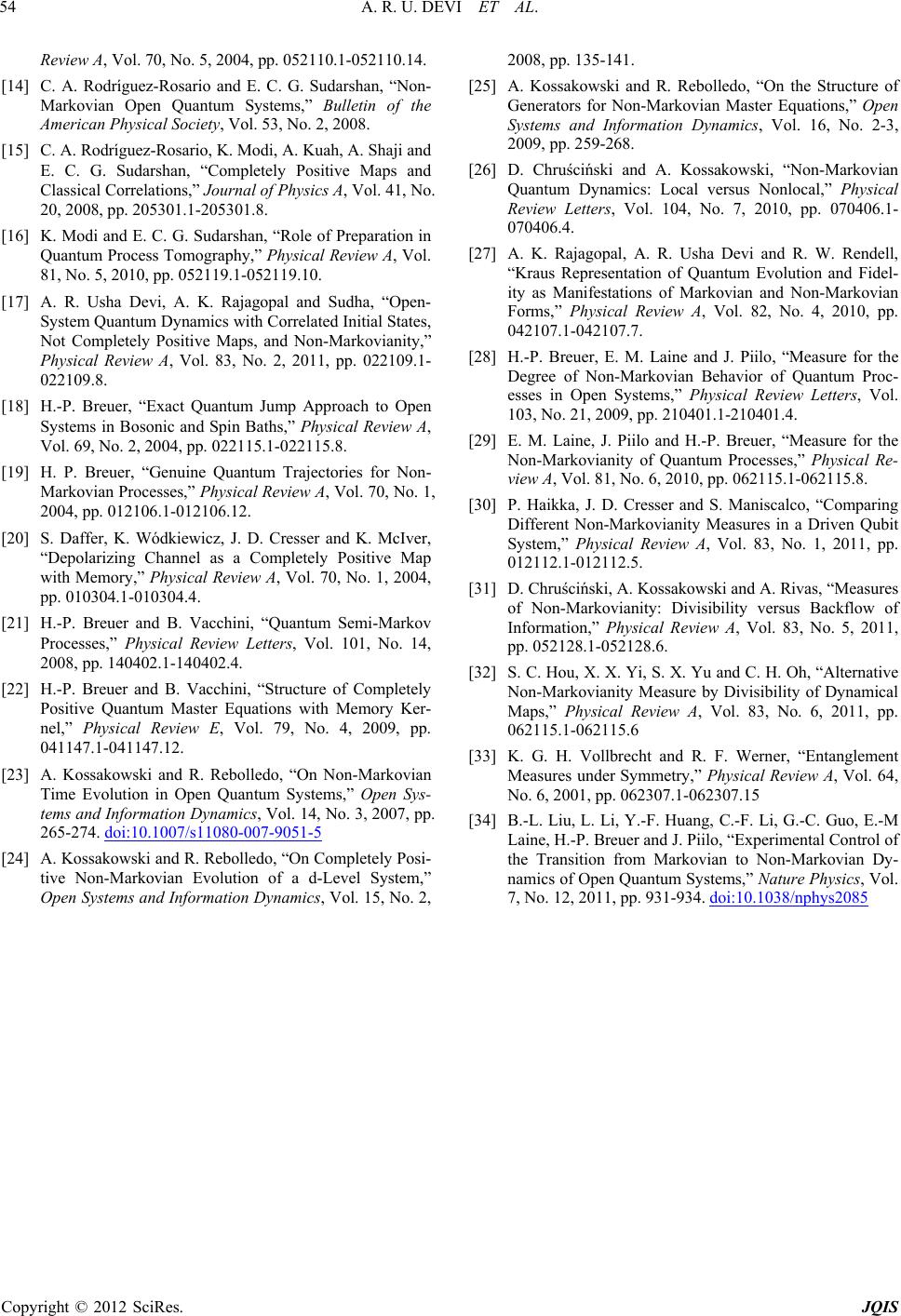 A. R. U. DEVI ET AL. Copyright © 2012 SciRes. JQIS 54 Review A, Vol. 70, No. 5, 2004, pp. 052110.1-052110.14. [14] C. A. Rodríguez-Rosario and E. C. G. Sudarshan, “Non- Markovian Open Quantum Systems,” Bulletin of the American Physical Society, Vol. 53, No. 2, 2008. [15] C. A. Rodríguez-Rosario, K. Modi, A. Kuah, A. Shaji and E. C. G. Sudarshan, “Completely Positive Maps and Classical Correlations,” Journal of Physics A, Vol. 41, No. 20, 2008, pp. 205301.1-205301.8. [16] K. Modi and E. C. G. Sudarshan, “Role of Preparation in Quantum Process Tomography,” Physical Review A, Vol. 81, No. 5, 2010, pp. 052119.1-052119.10. [17] A. R. Usha Devi, A. K. Rajagopal and Sudha, “Open- System Quantum Dynamics with Correlated Initial States, Not Completely Positive Maps, and Non-Markovianity,” Physical Review A, Vol. 83, No. 2, 2011, pp. 022109.1- 022109.8. [18] H.-P. Breuer, “Exact Quantum Jump Approach to Open Systems in Bosonic and Spin Baths,” Physical Review A, Vol. 69, No. 2, 2004, pp. 022115.1-022115.8. [19] H. P. Breuer, “Genuine Quantum Trajectories for Non- Markovian Processes,” Physical Review A, Vol. 70, No. 1, 2004, pp. 012106.1-012106.12. [20] S. Daffer, K. Wódkiewicz, J. D. Cresser and K. McIver, “Depolarizing Channel as a Completely Positive Map with Memory,” Physical Review A, Vol. 70, No. 1, 2004, pp. 010304.1-010304.4. [21] H.-P. Breuer and B. Vacchini, “Quantum Semi-Markov Processes,” Physical Review Letters, Vol. 101, No. 14, 2008, pp. 140402.1-140402.4. [22] H.-P. Breuer and B. Vacchini, “Structure of Completely Positive Quantum Master Equations with Memory Ker- nel,” Physical Review E, Vol. 79, No. 4, 2009, pp. 041147.1-041147.12. [23] A. Kossakowski and R. Rebolledo, “On Non-Markovian Time Evolution in Open Quantum Systems,” Open Sys- tems and Information Dynamics, Vol. 14, No. 3, 2007, pp. 265-274. doi:10.1007/s11080-007-9051-5 [24] A. Kossakowski and R. Rebolledo, “On Completely Posi- tive Non-Markovian Evolution of a d-Level System,” Open Systems and Information Dynamics, Vol. 15, No. 2, 2008, pp. 135-141. [25] A. Kossakowski and R. Rebolledo, “On the Structure of Generators for Non-Markovian Master Equations,” Open Systems and Information Dynamics, Vol. 16, No. 2-3, 2009, pp. 259-268. [26] D. Chruściński and A. Kossakowski, “Non-Markovian Quantum Dynamics: Local versus Nonlocal,” Physical Review Letters, Vol. 104, No. 7, 2010, pp. 070406.1- 070406.4. [27] A. K. Rajagopal, A. R. Usha Devi and R. W. Rendell, “Kraus Representation of Quantum Evolution and Fidel- ity as Manifestations of Markovian and Non-Markovian Forms,” Physical Review A, Vol. 82, No. 4, 2010, pp. 042107.1-042107.7. [28] H.-P. Breuer, E. M. Laine and J. Piilo, “Measure for the Degree of Non-Markovian Behavior of Quantum Proc- esses in Open Systems,” Physical Review Letters, Vol. 103, No. 21, 2009, pp. 210401.1-210401.4. [29] E. M. Laine, J. Piilo and H.-P. Breuer, “Measure for the Non-Markovianity of Quantum Processes,” Physical Re- view A, Vol. 81, No. 6, 2010, pp. 062115.1-062115.8. [30] P. Haikka, J. D. Cresser and S. Maniscalco, “Comparing Different Non-Markovianity Measures in a Driven Qubit System,” Physical Review A, Vol. 83, No. 1, 2011, pp. 012112.1-012112.5. [31] D. Chruściński, A. Kossakowski and A. Rivas, “Measures of Non-Markovianity: Divisibility versus Backflow of Information,” Physical Review A, Vol. 83, No. 5, 2011, pp. 052128.1-052128.6. [32] S. C. Hou, X. X. Yi, S. X. Yu and C. H. Oh, “Alternative Non-Markovianity Measure by Divisibility of Dynamical Maps,” Physical Review A, Vol. 83, No. 6, 2011, pp. 062115.1-062115.6 [33] K. G. H. Vollbrecht and R. F. Werner, “Entanglement Measures under Symmetry,” Physical Review A, Vol. 64, No. 6, 2001, pp. 062307.1-062307.15 [34] B.-L. Liu, L. Li, Y.-F. Huang, C.-F. Li, G.-C. Guo, E.-M Laine, H.-P. Breuer and J. Piilo, “Experimental Control of the Transition from Markovian to Non-Markovian Dy- namics of Open Quantum Systems,” Nature Physics, Vol. 7, No. 12, 2011, pp. 931-934. doi:10.1038/nphys2085
|